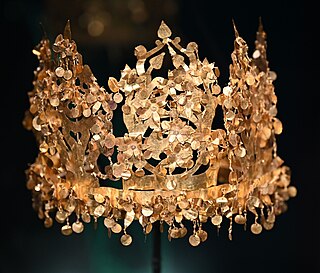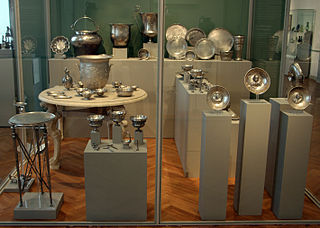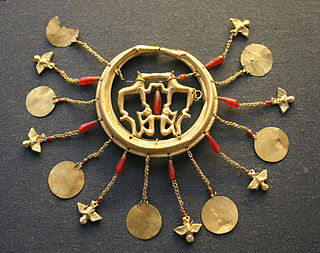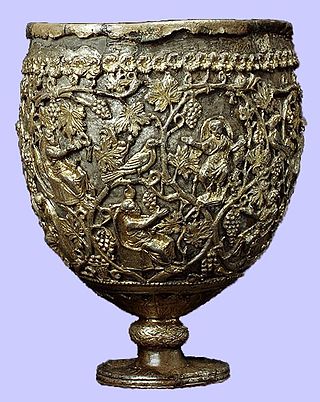
The Mildenhall Treasure is a large hoard of 34 masterpieces of Roman silver tableware from the fourth century AD, and by far the most valuable Roman objects artistically and by weight of bullion in Britain. It was found at West Row, near Mildenhall, Suffolk, in 1942. It consists of over thirty items and includes the Great Dish which weighs over 8 kg (18 lb).

Niello is a black mixture, usually of sulphur, copper, silver, and lead, used as an inlay on engraved or etched metal, especially silver. It is added as a powder or paste, then fired until it melts or at least softens, and flows or is pushed into the engraved lines in the metal. It hardens and blackens when cool, and the niello on the flat surface is polished off to show the filled lines in black, contrasting with the polished metal around it. It may also be used with other metalworking techniques to cover larger areas, as seen in the sky in the diptych illustrated here. The metal where niello is to be placed is often roughened to provide a key. In many cases, especially in objects that have been buried underground, where the niello is now lost, the roughened surface indicates that it was once there.


The Water Newton Treasure is a hoard of fourth-century Roman silver, discovered near the location of the Roman town of Durobrivae at Water Newton in the English county of Cambridgeshire in 1975. The hoard consisted of 27 silver items and one small gold plaque. Because of inscriptions found on some of the pieces in the collection it has been suggested that they may have been used in a local church, and they therefore comprise the earliest probable group of Christian liturgical silver yet found in the Roman Empire.

Tillya tepe, Tillia tepe or Tillā tapa is an archaeological site in the northern Afghanistan province of Jowzjan near Sheberghan, excavated in 1978 by a Soviet-Afghan team led by the Soviet archaeologist Viktor Sarianidi. The hoard found there is often known as the Bactrian gold.

The Hildesheim Treasure, unearthed on October 17, 1868 in Hildesheim, Germany, is the largest collection of Roman silver found outside imperial frontiers. Most of it can be dated to the 1st century AD. The trove consists of about seventy exquisitely crafted solid silver vessels for eating and drinking and is now kept in the Antikensammlung Berlin. It is generally believed that the treasure was the table service of a Roman commander, perhaps Publius Quinctilius Varus, who was militarily active in Germania. However, others also suggest that the treasure may have been war spoils rather than table service.

The Esquiline Treasure is an ancient Roman silver treasure that was found in 1793 on the Esquiline Hill in Rome. The hoard is considered an important example of late antique silver work from the 4th century AD, probably about 380 for the major pieces. Since 1866, 57 objects, representing the great majority of the treasure, have been in the British Museum.

The Mâcon Treasure or Macon Treasure is the name of a Roman silver hoard found in the city of Mâcon, eastern France in 1764. Soon after its discovery, the bulk of the treasure disappeared, with only 8 silver statuettes and a silver plate identified as being part of the original find. All of these objects are now in the British Museum

The Chaourse Treasure is a hoard of Roman silver found in Chaourse, a village near Montcornet, Aisne in northern France in 1883. Dating between the 2nd and 3rd centuries AD, the treasure is one of the most complete table services to survive from antiquity. This important hoard is now part of the British Museum's collection.

The Chatuzange Treasure is the name of an important Roman silver hoard found in the village of Chatuzange-le-Goubet in the department of Drôme, south-eastern France. Since 1893 it has been part of the British Museum's collection.

The Aegina Treasure or Aigina Treasure is an important Minoan gold hoard said to have been found on the island of Aegina, Greece. Since 1892, it has been part of the British Museum's collection. It is one of the most important groups of Minoan jewellery.

The Carthage Treasure is a Roman silver hoard, which was found in Tunis, Tunisia, at the site of the ancient city of Carthage. The treasure principally consists of silver tableware and jewellery, most of which is now held at the British Museum.

The Lampsacus Treasure or Lapseki Treasure is the name of an important early Byzantine silver hoard found near the town of Lapseki in modern-day Turkey. Most of the hoard is now in the British Museum's collection, although a few items can be found in museums in Paris and Istanbul too.

The Beaurains Treasure is the name of an important Roman hoard found in Beaurains, a suburb of the city of Arras, northern France in 1922. Soon after its discovery, much of the treasure was dispersed, to be sold on the antiquities market. The largest portion of the hoard can be found in the local museum in Arras and in the British Museum.

The Capheaton Treasure is an important Roman silver hoard found in the village of Capheaton in Northumberland, north-east England. Since 1824, it has been part of the British Museum's collection.

The Boscoreale Treasure is a large collection of exquisite silver and gold Roman objects discovered in the ruins of the ancient Villa della Pisanella at Boscoreale, near Pompeii, southern Italy. Consisting of over a hundred pieces of silverware, as well as gold coins and jewellery, it is now mostly kept at the Louvre Museum in Paris, although parts of the treasure can also be found at the British Museum.

The Corbridge Lanx is the name of a Roman silver dish found near Corbridge, Northern England in 1735. Once part of a large Roman treasure, only the silver lanx remains from the original find. The British Museum eventually purchased it in 1993.

Silver was important in Byzantine society as it was the most precious metal right after gold. Byzantine silver was prized in both the secular and domestic realms. Aristocratic homes had silver dining ware, and in churches silver was used for crosses, liturgical vessels such as the patens and chalices required for every Eucharist. Silver was also used as a medium in pagan mythological scenes and objects such as the Sevso Treasure. Silver pieces, especially silverware, continued to be rendered in the classical style into the seventh century.
The Traprain Law treasure is a hoard of late Roman hacksilver, found on the hillfort of Traprain Law during excavations in 1919. It is the largest hoard of Roman hacksilver currently known, weighing just over 23 kg. It consists mostly of Roman silver vessels, a few of which are complete but most of which had been cut into fragments or crushed. There are a few items of personal equipment and coins. The hoard was probably buried in the early fifth century AD. Early interpretations saw it as loot; more recent views prefer to see it as diplomatic gifts or payment for military service. It is currently on display in the National Museum of Scotland in Edinburgh.
























